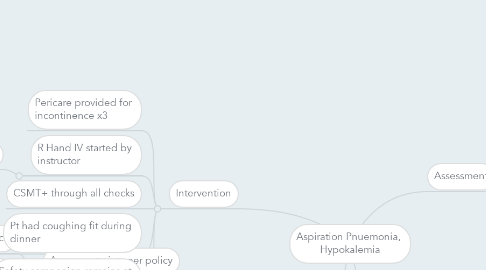Aspiration Pnuemonia, Hypokalemia
by Cody Unczur


1. Planning
1.1. Assess restraints per policy
1.1.1. q30 minute CMST check
1.1.2. release restraints and evaluate need q2 hours
1.2. Reposition q2 hours
1.3. Provide pericare
1.3.1. utilize barrier products
1.4. Safety companion with patient at all times
1.5. Monitor VS
1.5.1. Titrate oxygen to sats >90%
1.6. Administer Meds
1.6.1. 40 mEq KCl PO
1.6.2. D5 1/2NS + 20mEq KCl IVF. 70mL/hr continuous
1.7. Pt in high fowler's during eating and drinking
2. Intervention
2.1. Pericare provided for incontinence x3
2.2. R Hand IV started by instructor
2.2.1. L Hand IV removed
2.3. CSMT+ through all checks
2.4. Pt had coughing fit during dinner
2.4.1. Airway remains patent, LSC.
2.5. Safety companion remains at bedside
2.5.1. Ensuring pt keeps NC in place
3. Assessment
3.1. VS
3.1.1. RR 28
3.1.2. O2 Sat 95% on 5L High Flow NC
3.2. Incontinent of stool and urine
3.3. Pt pulling at O2 and IV tubing
3.3.1. Soft wrist restraints in place for safety
3.3.2. Safety companion at bedside
3.4. Diet
3.4.1. Pudding Thick fluids
3.4.2. Puree solids
3.5. Bed Rest
3.6. Labs
3.6.1. K+ 3.3
3.7. Diagnostics
3.7.1. CT Head Stroke Protocol Negative
3.7.2. MRI Brain Negative
3.7.3. CXR Positive. Indicative of aspiration pneumonia

